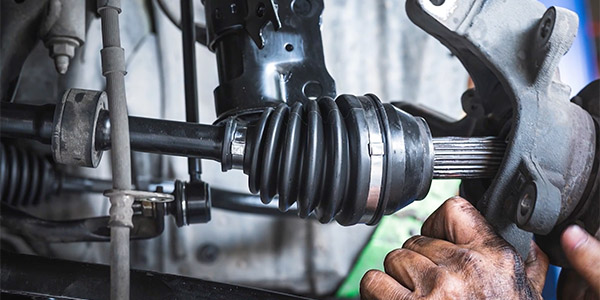Your customers’ tie rod ends are a key component to helping their tires wear evenly. More importantly, they play a critical safety role as well.
A failed tie rod could lead to loss of steering control or the wheel breaking completely free of the vehicle. Both are extremely dangerous situations that can be avoided by proactive maintenance. Symptoms of worn outer tie rods include:
• Loose vehicle steering, or play in the steering wheel
• Uneven tire wear
• Vehicle pulling
• Noises like clicks/rattling/chuckling
Many different types of steering and suspension problems exhibit the same symptoms and noises. Always perform a visual inspection on every steering and suspension component on the vehicle. For tie rods, a visual inspection will determine if there is excessive wear or damage to the boot cover, which can reduce performance or even cause the tie rod to fail completely.
Some ball joints and almost all tie rod ends use a tapered stud and hole with a nut on top to secure the stud to the steering knuckle. The 7-10º angled taper, along with a threaded stud and nut, lock the components together by tensioning the nut and stud.
Torque-to-yield (TTY) ball joints and tie-rod studs can weigh less and still apply the same clamping loads, with the added benefit of having clamping loads that are more consistent and controllable.
Sometimes, you can tell the difference between torque to yield and regular bolts by their appearance. The metallurgy and heat treatments may make them look different, and TTY ball joints and studs have an inset hex head at the end of the stud. Regardless, always check service information to determine the correct torque for steering and suspension components, no matter what type of fastener you’re working with. If you see an initial torque spec along with an angle in degrees, it’s a TTY fastener.
TTY ball joints and tie rods are usually installed dry. Do not apply any oil, grease, assembly lube or sealer on the stud or tapered bore. Lubricants increase the torque load on the bolt or stud, which may overload and stretch a TTY bolt too far, causing it to break. The increased torque can also cause the inner opening of the taper to crack due to excessive clamping force.
Many ball joints can have an initial torque spec as low as 15-30 ft/lbs and torque angles between 140º and 225º. Never try to guess or use your “calibrated elbow!” Instead, look up the spec and use a torque wrench. Also, make sure the washers on the studs are in good condition and installed in the right direction. If a washer splits or fails, it could cause a catastrophic failure. When castle nuts are used, be sure to correctly install a cotter pin. After performing the correct torque procedure, if the hole in the nut doesn’t line up with the hole in the stud, it’s OK to turn the nut slightly tighter in order to align the cotter pin.
Even if you don’t plan to install a new tie rod or ball joint, always check service information to determine if a TTY ball joint or tie rod end is reusable after removal.
Once a new part is installed, perform a final visual check of the other steering and suspension components before reinstalling the wheel. Torque the wheel nuts with the vehicle on the ground and go for a short road test. Immediately following the road test, perform (or arrange for) a wheel alignment. When tie rods are replaced, don’t rely on the common practice of “counting the threads” (adjusted /installed length) of the old tie rod and attempting to duplicate that installed length with the new tie rod. You ‘might’ get the wheel toe (alignment) ‘close’ (assuming the vehicle was in proper wheel alignment before you worked on it) or it might now be off by a few degrees. That’s enough to cause tire wear! Whenever a wheel alignment is performed, check service information to determine if you need to perform a relearn / reset of the vehicle’s steering angle sensor.
Finally, on vehicles with EPS (Electric Power Steering) or ADAS (Advanced Driver Assist System), consult service information to see if a “pre and post” repair vehicle scan is advisable prior to returning the vehicle to the customer. Service information is also valuable in determining if any ADAS camera or radar sensors need to be calibrated or relearned following steering & suspension repairs or wheel alignments.
For more information on resetting the steering angle sensors and other technical tips, visit DelphiAftermarket.com.
This video is presented by The Group Training Academy.













